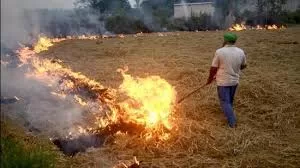New Delhi, February 5, 2025 – A recent study by Japanese researchers has challenged the prevailing notion that crop residue burning (CRB) in Punjab and Haryana is a major contributor to the high PM2.5 levels in Delhi-NCR. The study, conducted under the Aakash Project by the Research Institute for Humanity and Nature (RIHN) in Kyoto, analyzed data from a network of 30 monitoring sites and concluded that crop fires are not the primary cause of air pollution in the national capital.
The research findings, published in the journal npj Climate and Atmospheric Science, indicate that even during the peak stubble burning period of October and November, air pollution in Delhi-NCR is largely independent of CRB. Instead, the study highlights that local pollution sources play a more significant role in determining air quality levels in the region.
Key Findings of the Study
Lead author Dr. Poonam Mangaraj emphasized the need for continuous monitoring across Punjab (source region), Haryana (intermediate region), and Delhi-NCR (receptor region) to develop targeted air pollution mitigation strategies. The researchers deployed 30 compact PM2.5 monitoring instruments with gas sensors (CUPI-Gs) that recorded air pollutant levels in 2022 and 2023.
The study utilized multiple methodologies, including:
- Low-cost CUPI-G network measurements
- Analyses of air mass trajectories, fire counts, and wind patterns
- Chemistry-transport simulations
Findings from the research showed that despite a significant decline in satellite fire detection counts (FDCs) over Punjab and Haryana between 2015 and 2023, PM2.5 concentrations in Delhi remained consistently high.
Meteorological Influence on Air Quality
The study noted that meteorological conditions had a profound impact on pollution levels. In November 2022, northwesterly winds transported pollutants from Punjab and Haryana to Delhi-NCR on two occasions. In contrast, in November 2023, southwesterly low wind conditions and limited air movement led to an accumulation of locally generated pollutants in Delhi-NCR.
Further, the data suggested that variations in PM2.5 concentrations corresponded more closely with the implementation or revocation of the Graded Response Action Plan (GRAP) stages by the Commission of Air Quality Management (CAQM). This reinforces the argument that local pollution sources, rather than crop burning, are the dominant factors affecting air quality in Delhi-NCR.
Implications for Policy and Air Quality Management
The study’s findings highlight the need for a shift in the air pollution mitigation strategy. Rather than focusing solely on CRB as the primary culprit, policymakers should consider addressing local emissions from vehicular traffic, industrial activities, and construction dust as part of a comprehensive pollution control approach.
“With the measurements at a network of about 30 sites covering Punjab, Haryana, and Delhi-NCR, we are able to separate the contributions of paddy straw burning to Delhi’s PM2.5 variations based on characteristic pollution events and weekly-monthly averages,” said Prof. Prabir Patra, the leader of the Aakash Project and principal scientist at the Japan Agency for Marine-Earth Science and Technology (JAMSTEC).
Disclaimer:
This study presents findings based on scientific data collected over a specific period and does not rule out the influence of CRB on air quality in Delhi-NCR under different meteorological conditions. While it suggests that local pollution sources are more significant contributors to PM2.5 levels, further research and continuous monitoring are required to develop comprehensive air quality management strategies.
The results of this study should not be interpreted as an endorsement or dismissal of any existing policies but rather as an additional perspective to guide air pollution control measures effectively.











